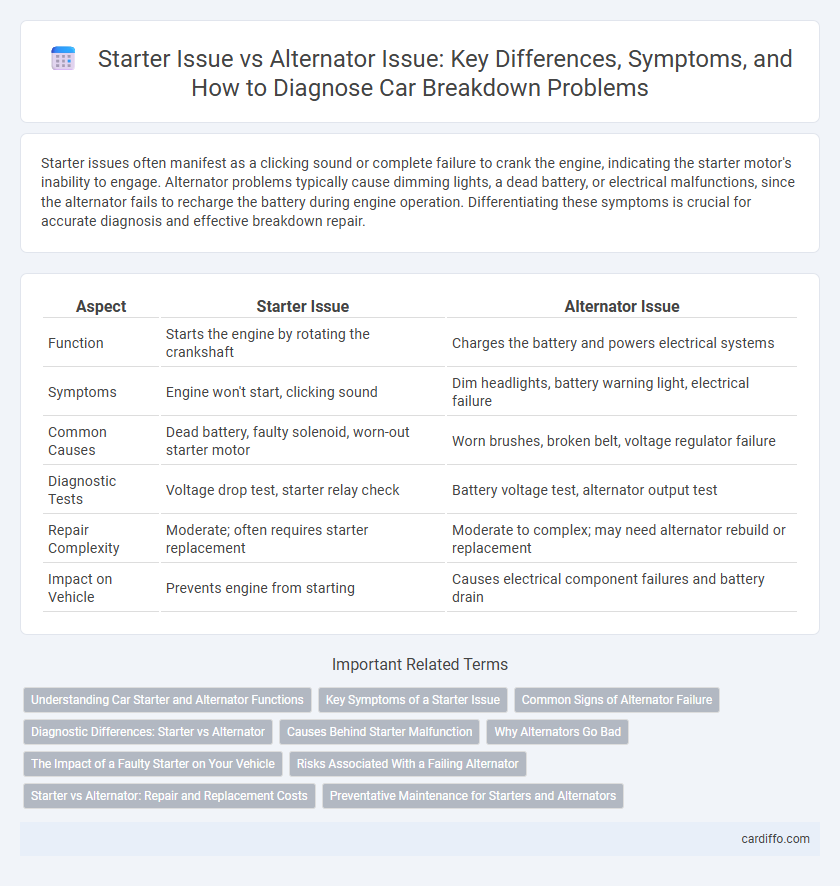Starter issues often manifest as a clicking sound or complete failure to crank the engine, indicating the starter motor's inability to engage. Alternator problems typically cause dimming lights, a dead battery, or electrical malfunctions, since the alternator fails to recharge the battery during engine operation. Differentiating these symptoms is crucial for accurate diagnosis and effective breakdown repair.
Table of Comparison
| Aspect | Starter Issue | Alternator Issue |
|---|---|---|
| Function | Starts the engine by rotating the crankshaft | Charges the battery and powers electrical systems |
| Symptoms | Engine won't start, clicking sound | Dim headlights, battery warning light, electrical failure |
| Common Causes | Dead battery, faulty solenoid, worn-out starter motor | Worn brushes, broken belt, voltage regulator failure |
| Diagnostic Tests | Voltage drop test, starter relay check | Battery voltage test, alternator output test |
| Repair Complexity | Moderate; often requires starter replacement | Moderate to complex; may need alternator rebuild or replacement |
| Impact on Vehicle | Prevents engine from starting | Causes electrical component failures and battery drain |
Understanding Car Starter and Alternator Functions
The car starter is responsible for initiating the engine's operation by turning the engine over when the ignition key is engaged, while the alternator maintains the vehicle's electrical system by charging the battery and powering electrical components during engine operation. Starter issues typically manifest as a clicking sound or failure to start the engine, whereas alternator problems often cause dimming lights, battery warning lights, or electrical failures. Understanding these distinct functions and symptoms is crucial for accurate diagnosis and timely repair of electrical system breakdowns.
Key Symptoms of a Starter Issue
Key symptoms of a starter issue include a clicking sound when turning the ignition, a sluggish or unresponsive engine crank, and complete failure to start the vehicle despite a fully charged battery. Unlike alternator problems, which cause dimming lights and electrical malfunctions while the engine runs, starter issues prevent the engine from turning over initially. Diagnosing these symptoms promptly helps avoid further electrical system damage and costly repairs.
Common Signs of Alternator Failure
Common signs of alternator failure include dim or flickering headlights, battery warning light appearing on the dashboard, and electrical components such as power windows or radio malfunctioning. A failing alternator often leads to a dead battery as the device stops charging it during engine operation. Unusual noises like grinding or whining from the engine area can also indicate alternator problems rather than starter issues.
Diagnostic Differences: Starter vs Alternator
Diagnosing starter issues involves checking for clicking sounds, lack of engine crank, or intermittent starting failures, often linked to a faulty solenoid or worn starter motor. Alternator problems typically manifest as dimming headlights, battery warning lights on the dashboard, or electrical accessory malfunctions, indicating charging system failure. Voltage testing is crucial; a defective starter will show no output during start attempts, while a failing alternator reveals inconsistent voltage measurements (usually below 13.5 volts) when the engine is running.
Causes Behind Starter Malfunction
Starter malfunction commonly results from worn-out brushes, a faulty solenoid, or electrical connection problems such as corroded or loose wiring. Alternator issues typically involve belt problems or diode failure, which do not directly affect starter performance. Diagnosing starter failure requires checking the battery voltage, ignition switch condition, and starter relay to isolate the root cause accurately.
Why Alternators Go Bad
Alternators go bad primarily due to worn-out brushes, faulty voltage regulators, and damaged diodes which disrupt the conversion of mechanical energy into electrical power. Heat buildup and exposure to dirt or moisture accelerate wear, causing the alternator to fail prematurely. Understanding these common failure modes helps differentiate alternator problems from starter issues, which are typically linked to battery or solenoid faults.
The Impact of a Faulty Starter on Your Vehicle
A faulty starter prevents the engine from turning over, making it impossible to start the vehicle and leaving you stranded. Unlike alternator issues that affect battery charging and electrical systems, starter problems directly impede ignition. Diagnosing starter faults early helps avoid more extensive damage and costly towing or repairs.
Risks Associated With a Failing Alternator
A failing alternator can lead to battery drain, causing the vehicle to stall unexpectedly and leaving drivers stranded. Unlike starter issues, which typically affect engine ignition, alternator problems impact the entire electrical system, risking damage to critical components like the ECU and headlights. Timely diagnosis of alternator faults prevents costly repairs and ensures reliable vehicle performance.
Starter vs Alternator: Repair and Replacement Costs
Starter repair costs typically range between $150 and $400, with replacement prices reaching $300 to $600 depending on the vehicle model and labor fees. Alternator repair or rebuild expenses generally fall between $100 and $300, while full alternator replacements can cost from $400 to $700, variable by brand and complexity. Understanding these cost differences helps prioritize repairs, as starters mainly impact engine ignition, while alternators affect battery charging and electrical system stability.
Preventative Maintenance for Starters and Alternators
Regular preventative maintenance on starters and alternators significantly reduces the risk of breakdowns by ensuring optimal electrical system performance. Inspecting and cleaning connections, testing voltage output, and replacing worn components prevent common issues such as starter failure or alternator malfunction. Routine maintenance extends the lifespan of starters and alternators, minimizing costly repairs and vehicle downtime.
Starter issue vs alternator issue Infographic

 cardiffo.com
cardiffo.com